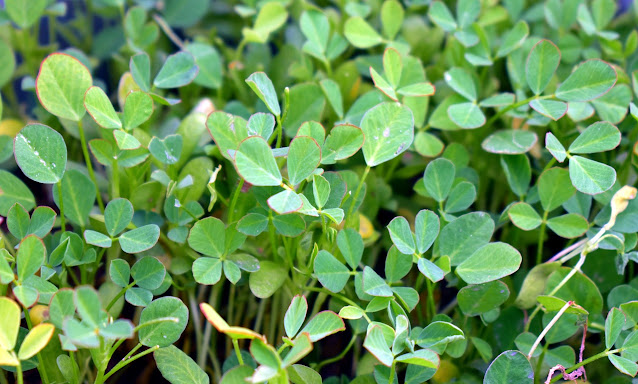Cultivation of Fenugreek / Methi
Fenugreek / Methi belongs to the family Leguminosae. Major growing types of Fenugreek are –
Fenugreek is used as a Leafy vegetable as well as a pulse.it is an annual herb and the leaves and young pods are used as vegetables and the seed as condiments improve the flavor and nutritive value of food. India has a major contribution to Global fenugreek production. Rajasthan occupies more than 80% share of the total fenugreek production in the country other major growing states are UP, Chhattisgarh , Gujrat, and MP. It has also some medicinal value. It prevents constipation, removes indigestion, stimulates the spleen and liver, and is appetizing and diuretic. The leaves are quite rich in protein, minerals, and Vitamin C
Potassium -31.0 mg , Sulphur -167.0 mg, Riboflavin- 0.15mg Nicotinic acid mg- 0.70 , Vitamin C -5 4.0 Vitamin A:6,450 I.U.
Fenugreek is considered to be native of Eastern Europe and Ethiopia and is found growing wild in North-Western India.
common methi is growing and produces upright shoots whereas kasuri methi is slow growing initially and remains in a rosette condition during most of its vegetative period.
Fenugreek can be grown on any type of soil, but loamy soils are best suited for its cultivation. The soil should be free from bad drainage.
The land should be prepared thoroughly.
|
Variety |
Developed By |
Characteristics |
|
Hisar Suvarna |
HAU , Hissar |
A quick growing, erect and tall, dual purpose, medium maturity (130-140days) , moderately resistant to percospora and powdery mildew.Wider adaptability,suitable for cultivation throughout the country Av. Yield 16 q/hac |
|
Hisar Madhavi |
HAU , Hissar |
A quick growing, erect and tall, dual purpose, medium maturity (130-140days) , moderately resistant to powdery mildew and to downy mildew .A variety with under adaptability suitable for both irrigated and rainfed condition. Av. Yield 19 q/hac |
|
Hisar Muktha |
|
A quick growing seedtype variety, medium maturity (135-140days) , moderately resistant to powdery mildew and to downy mildew.Erect and tall plants.Wide adaptability.Suitable for both irrigated and rainfed condition . Av. Yield 20 q/hac |
|
RMt 303 |
|
Medium maturity variety (145- 150 days) seeds bold ,with typical yellow colour ,less susceptible to powdery mildew Av. Yield 19 q/hac |
|
RMt305 |
|
First determinant type, multipodant, early maturing, wider adaptability, resistant to powdery mildew and rootknot nematodes .Seeds bold, attractive and yellow, duration 120-125 days. Av. Yield 13 q/hac |
|
Guj Methi 1 |
|
The first variety from Gujarat released for the state.Plant dwarf. Av. Yield 18 q/hac |
|
Pant Ragini |
GBPU&T , Pantnagar |
A dual purpose tall bushy type resistant to downy mildew and root rots, medium maturity. Seed contain 2-2.5% essential oil Av. Yield 12 q/hac |
|
Rajendra kanti |
|
Medium sized bushy plant; early maturity, suitable for intercropping in both kharif and rabi season, field tolerant to cercospora leaf spot, powdery mildew and aphids. Av. Yield 13 q/hac |
|
CO -1 |
|
A quick growing, dual purpose , early maturing variety tolerant to root rot disease. Seeds contain 21.7% protein. Av. Yield 6 .8q/hac |
|
CO 2 |
|
Short duration dual purpose variety , field tolerant to Rhizoctonia root rot disease, suitable for both kharif and rabi season.Early maturity,short duration. Av. Yield 4 q/hac |
(a) Sowing time. Desi methi is sown from the middle of September to the middle of November for seed production and from the middle of September to the middle of March for green leaves, Kasuri methi is sown in the middle of December. The seed is generally sown by the broadcasting method.
(b) Seed rate. The seed rate is 10.0 kg per acre for common methi and 8 kg for Kasuri methi.
Manuring
Aftercare
One or two weedings may be given during the early stages of growth. Soil should contain sufficient moisture. The first irrigation is given just after sowing and subsequent irrigations are given at seven to ten days interval.
Harvesting
The Kasuri methi and desi methi become ready for harvesting 25 to 30 days and 20 days after sowing respectively. The picking of leaves is done by nipping at the ground level and subsequent cuttings are done at an interval of 12 to 15 days. Sometimes after taking two to three cuttings, the plants are
Vegetable Crops of India left to produce seed or they have uprooted after 4 to 5 cuttings. The leaves, if allowed to over mature, may taste bitter.
The yield of common methi is 2800 kg and Kasuri type is 3600-4000 kg per acre.



Hello! I just would like to give a huge thumbs up for the great info you have here on this post. I will be coming back to your blog for more soon.